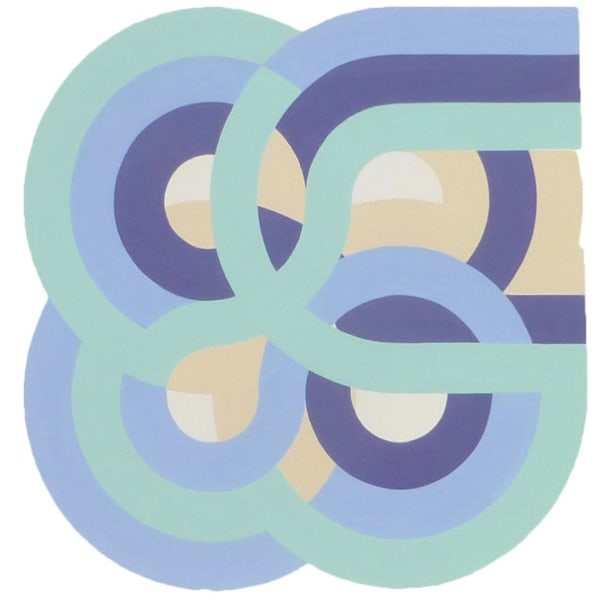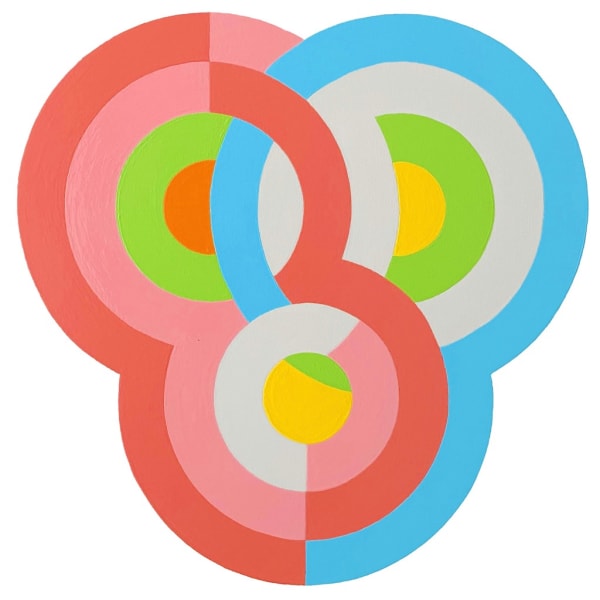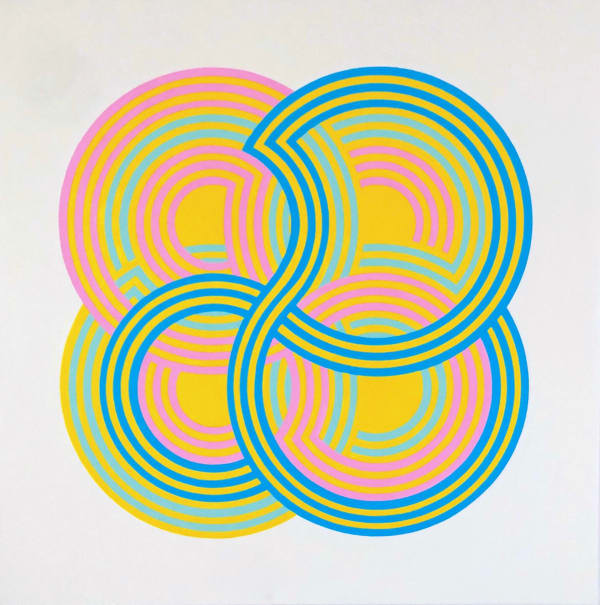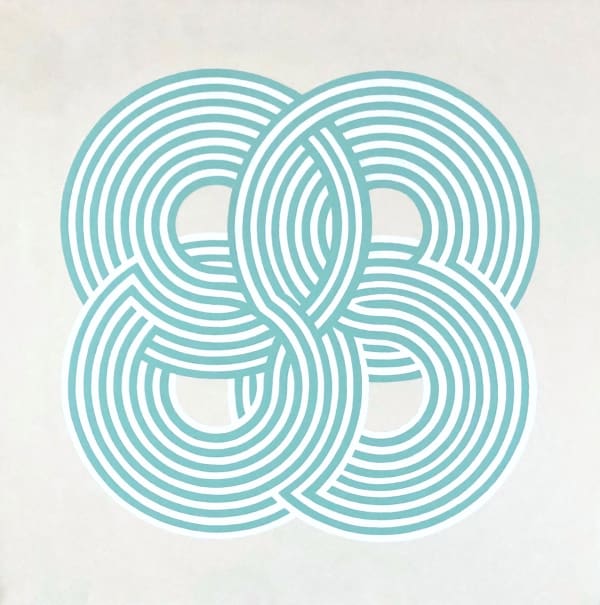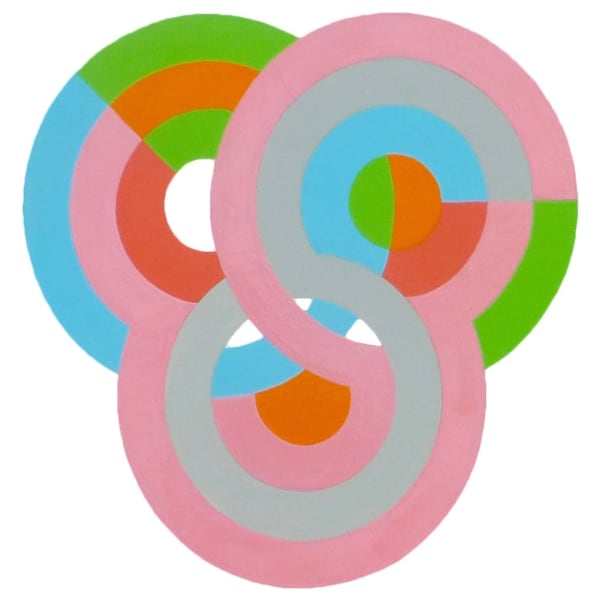Orlando Campbell
Orlando Campbell is as a distinguished contemporary British artist whose sophisticated to abstraction has earned him recognition for his innovation while engaging with the complex realities of our time. Raised in Chelsea, London, Campbell's artistic trajectory was profoundly shaped by his early exposure to modernist masters Frank Stella, Patrick Caulfield, Kenneth Noland, and Eduardo Paolozzi, whose revolutionary approaches to color and geometric abstraction would later influence his distinctive artistic vocabulary
Campbell's paintings accentuate pure form, colour, and spatial harmony. Applied with flat, vibrant hues, the artist eschews expressive flourishes in favour of delineated patterns and geometry entwined in their compositions. His approach is rooted in the tradition of abstraction and American colour field painting, a movement that emerged in the mid-20th century and emphasised the expressive use of colour, form, and gesture in painting. However, Campbell brings his unique style and contemporary sensibilities to this tradition, creating fresh and compelling artworks.
His compositions of curved, overlapping lines and shapes are precisely arranged and meticulously painted, stripped of unnecessary detail, and presented with a sense of directness and immediacy, inviting viewers to focus on the fundamental elements; an exploration of how colours and form interact and affect each other when placed in close proximity.
The artist employs a wide range of hues, from bold and saturated tones to subtle and muted shades, creating a sense of depth and complexity in his works. His approach to colour is highly intentional in using unexpected and unconventional choices to emphasise the form and structure of his works, creating a sense of balance and visual rhythm that engage the viewer's eye and evoke moving responses.
Most recently, Campbell has been inspired by the pigments in Tricolour flags, engaging the symbolic use of colour in abstraction to signal current cultural affairs. Campbell's skilful handling of colour creates a visual impact that is both captivating and immersive, drawing the viewer into his painted worlds.
Campbell's bold and geometric forms are a hallmark feature of contemporary abstraction. Often employing precise and meticulously constructed shapes arranged in complex and dynamic compositions characterised by geometry, his paintings exude a sense of visual complexity and spatial depth on a flat plain, inviting viewers to engage with the intricate frisson between geometry and colour in our natural and urban environment.
Intrigued by the mechanics of engineering, science, and technology, Campbell investigates the possibilities of his art with the juxtaposition of colour, diagrams, molecules, atoms and strands of DNA. These latest works became known at the Curly Wurly's and Venns, and he also created his sculpture series of Pills.
Beyond his painting practice, Campbell's sculptural works draw upon his fascination with raw construction. Pills are an evolving series of sculptures relating to scientific investigations of molecules, atoms, and DNA strands as intertwining energy forces. The symmetry and contrasting colours of his tubular forms also delineate from his experiences of unearthing the ground beneath us, recognising the bright cables that cross our valleys and streets are the connective forces that carry power and supplies for life's comfort. All these cable lines underground, pipes, and pills, are vessels offering us a veritable cocktail to soothe our needs, dosages of pleasure, pain, and a panacea in whatever measure. Campbell's Pills reflect the technological and scientific capabilities of our age, and on which our civilisation has come to depend.
Campbell investigates a diverse range of subjects from art, science and psychology as a conceptual framework to explore the relationship between language, perception, and cognition in his art. His most recent paintings recall abstract representations of Pointillism while examining the Stroop effect in psychology and Ishihara colour blind tests as a conceptual basis to create artworks that challenge the viewer's perception and cognitive processes. Here, he uses a series of conflicting words, dots, patterns, and colours to create paintings that evoke a unique visual experience, intentionally distorting or manipulating the image to challenge the viewer's sense of perception. In this sense, Campbell's paintings are a metaphorical representation of the limits of human perception and the subjective nature of reality.
-
 Orlando CampbellColour Blind Eye Test, 2019view more details
Orlando CampbellColour Blind Eye Test, 2019view more details -
 Orlando CampbellKI Curly Wurlys III, 2019view more details
Orlando CampbellKI Curly Wurlys III, 2019view more details -
 Orlando CampbellKI Curly Wurlys IV, 2019view more details
Orlando CampbellKI Curly Wurlys IV, 2019view more details -
 Orlando CampbellVenn IV, 2019view more details
Orlando CampbellVenn IV, 2019view more details -
 Orlando CampbellAdidas crop circle, 2018view more details
Orlando CampbellAdidas crop circle, 2018view more details -
 Orlando CampbellTwo colour adidas crop circle, 2018view more details
Orlando CampbellTwo colour adidas crop circle, 2018view more details -
 Orlando CampbellVenn II, 2017view more details
Orlando CampbellVenn II, 2017view more details -
 Orlando CampbellThe ebb and flo, 2016view more details
Orlando CampbellThe ebb and flo, 2016view more details



